In this article we will demonstrate 5 ways to create a search box in Excel with Conditional Formatting. We’ll use the following dataset containing the Customer Name, Product, and State of a company to illustrate our methods.
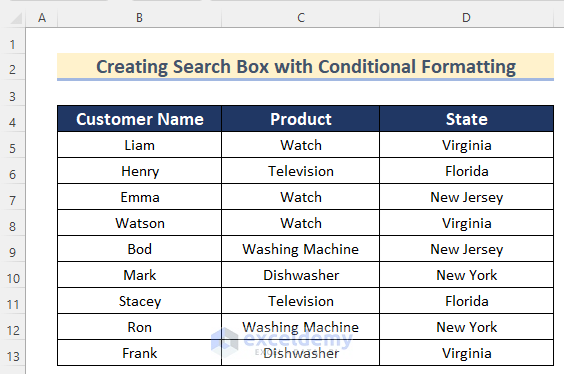
Method 1 – Using the SEARCH, IF, and ISBLANK Functions to Create a Search Box in Excel
In our first method, we’ll use the SEARCH, IF, and ISBLANK functions with Conditional Formatting. The SEARCH function returns a particular string from the given range, and the ISBLANK function is used to check if a cell is empty or not, returning True or False.
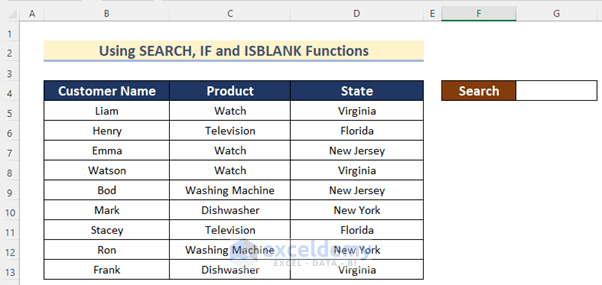
Steps:
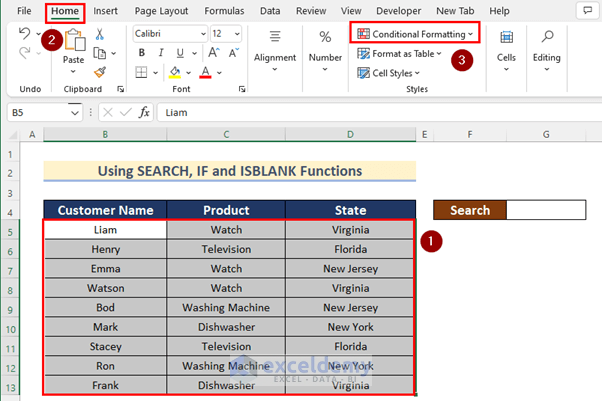
- Select New Rule.
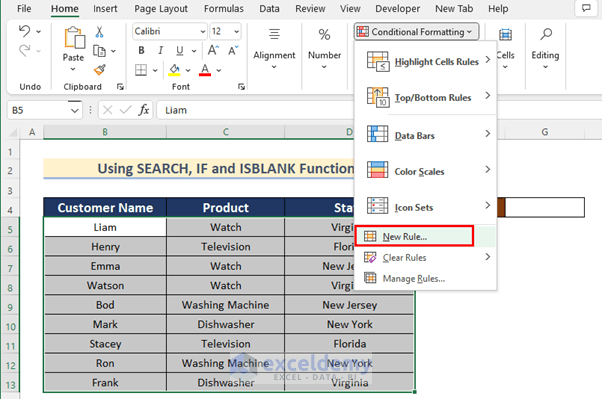
The New Formatting Rule box will open.
- Select Use a formula to determine which cells to format.
- Insert the following formula in the box:
=IF(ISBLANK($G$4),0,SEARCH($G$4,$B5&$C5&$D5))Here, we check if Cell G4 is blank or not using the ISBLANK function. If TRUE, 0 is returned, else the SEARCH function will search for the value of cell G4 and adjacent data in columns B, C and D.
- Click on Format.
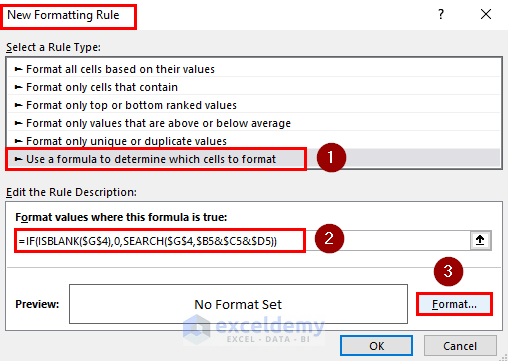
The Format Cells box will open.
- Click on the Fill option.
- Select any Background Color of your choice. Here, we select Green, Accent 6, and Lighter 80%.
- Click on OK.
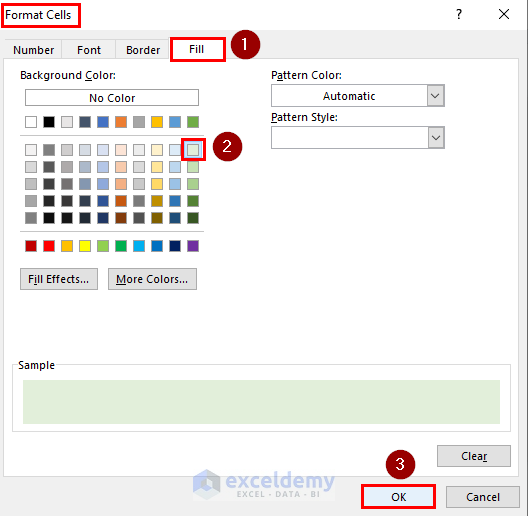
Again, the New Formatting Rule box will appear.
- Click on OK.
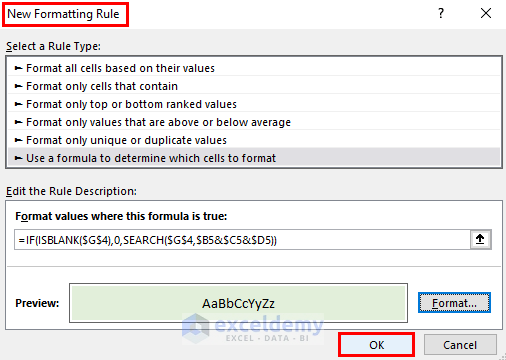
Now, if you enter a value in cell G4 that is in the selected cell range, the matching cell and its corresponding cells will be formatted as specified.
- Insert Virginia in cell G4.
The ranges B5:D5, B8:D8, and B13:D13 will be formatted according to the formula used in Conditional Formatting.
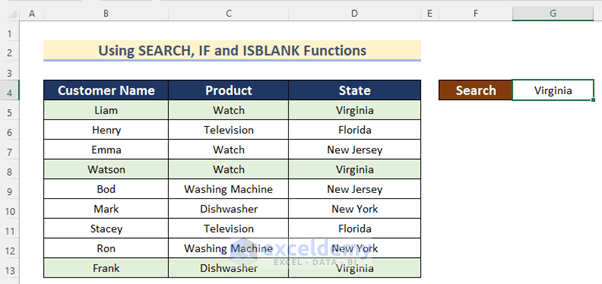
Read More: How to Create a Search Box in Excel
Method 2 – Using a Combination of Functions to Create a Search Box in Excel with Conditional Formatting
We can also create a search box using the AND, ISNUMBER, and SEARCH functions. The ISNUMBER function checks if a cell contains a number or not. The AND function checks multiple arguments and if all the arguments are True then it will return True else False.
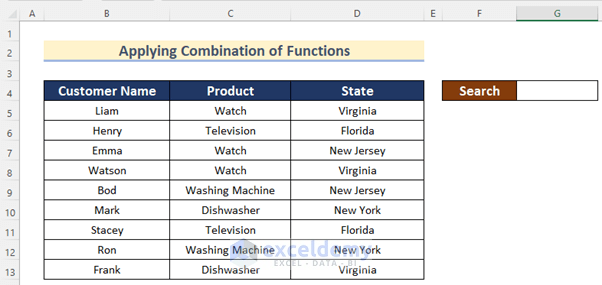
Steps:
- Follow the steps shown in Method 1 to open the New Formatting Rule box.
- Select Use a formula to determine which cells to format.
- Insert the following formula in the box:
=AND($G$4<>"",ISNUMBER(SEARCH($G$4,$B5&$C5&$D5)))Here, we check if cell G4 is a number with the ISNUMBER Function. If TRUE, 0 is returned, else the SEARCH function will search for the value of cell G4 and adjacent data in columns B, C and D.
- Click on Format.
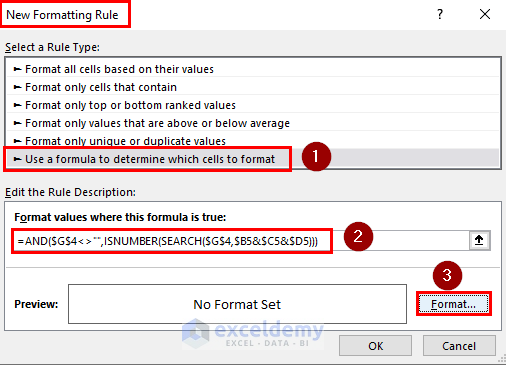
- Change the Format where the formula is True by going through the steps shown in Method 1.
- Insert Florida in cell G4.
The ranges B6:D6 and B11:D11 are formatted according to the formula we used in Conditional Formatting.
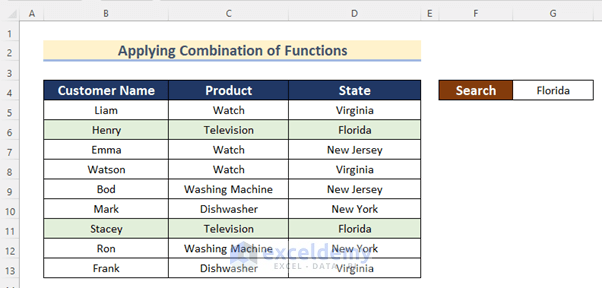
Read More: How to Create a Search Box in Excel for Multiple Sheets
Method 3 – Using a Name Box to Create a Search Box with Conditional Formatting
Now let’s create a search box using a Name Box with Conditional Formatting.
Steps:
- Select cell G4.
- Type Search_box in the Name Box.
- Press ENTER.
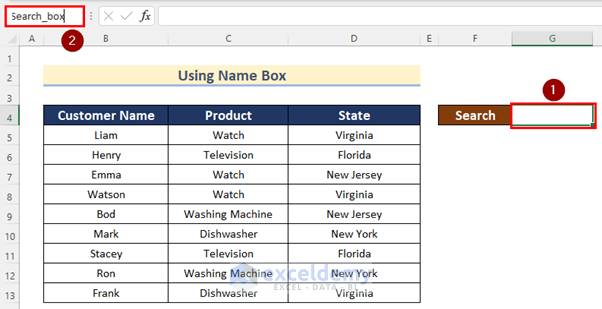
- Follow the steps shown in Method 1 to open the New Formatting Rule box.
- Select Use a formula to determine which cells to format.
- Insert the following formula in the box:
=IF(ISBLANK(Search_box),0,SEARCH(Search_box,$B5&$C5&$D5))- Click on Format.
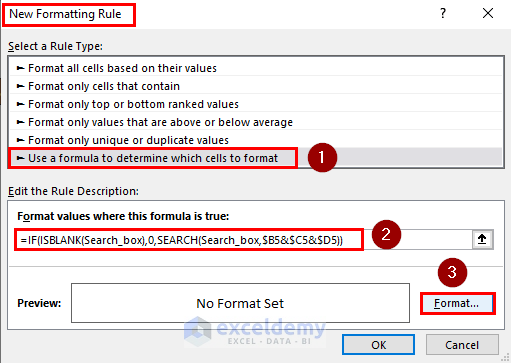
- Change the Format where the formula is True by going through the steps shown in Method 1.
- Enter Florida in cell G4.
The ranges B6:D6 and B11:D11 are formatted according to the formula we used in Conditional Formatting using the Name Box.
Method 4 – Using a Text Box from ActiveX Controls to Create a Search Box with Conditional Formatting
Steps:
- Go to the Developer tab >> click on Insert >> select Text Box from ActiveX Controls.
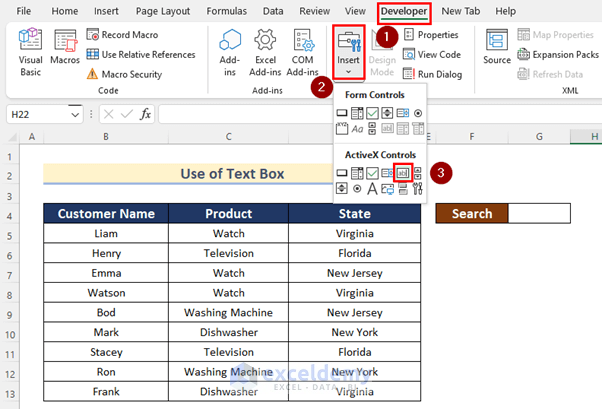
- Insert a Text Box and right-click on it.
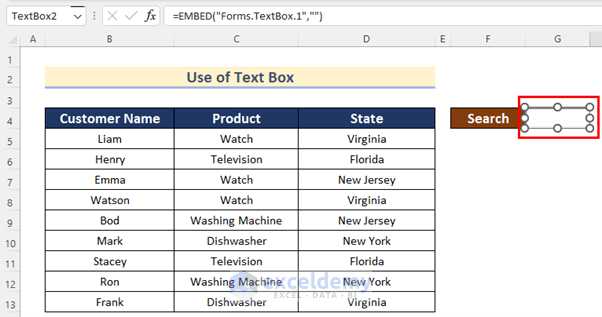
- Click on Properties.
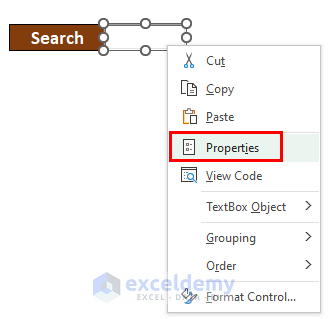
The Properties box will open.
- Select the Alphabetic option.
- Enter cell G4 as the linked cell.
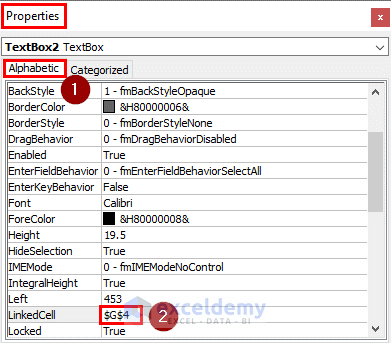
- Enter Florida in cell G4.
This data will automatically be inserted into the Text Box.
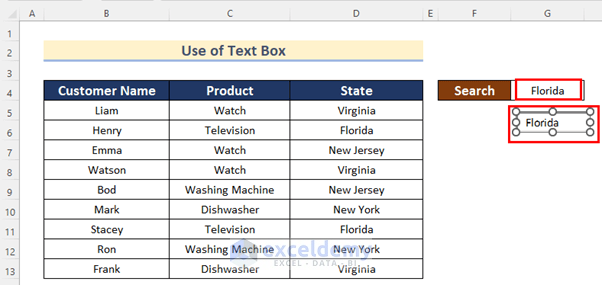
- Follow the steps shown in Method 1 to open the New Formatting Rule box.
- Select Use a formula to determine which cells to format.
- Insert the following formula in the box:
=AND($G$4<>"",ISNUMBER(SEARCH($G$4,$B5&$C5&$D5)))Here,we check if cell G4 is a number using the ISNUMBER Function. If TRUE, 0 is returned, else the SEARCH function will search for the value of cell G4 and adjacent data in columns B, C and D.
- Click on Format.
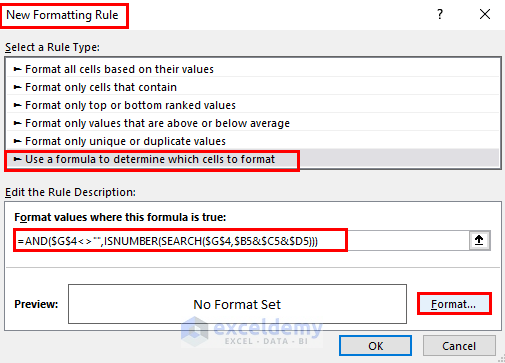
The ranges B6:D6 and B11:D11 are formatted according to the formula we used in Conditional Formatting by using a Text Box.
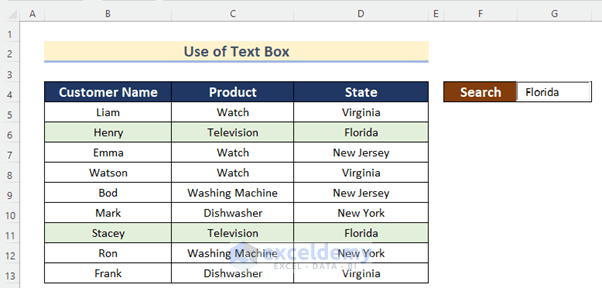
Method 5 – Using Data Validation with Conditional Formatting
In the final method, we will create a search box using Data Validation with Conditional Formatting. We will search for a particular value in a particular column using Data Validation, while preventing input of any data that does not exist in the dataset.
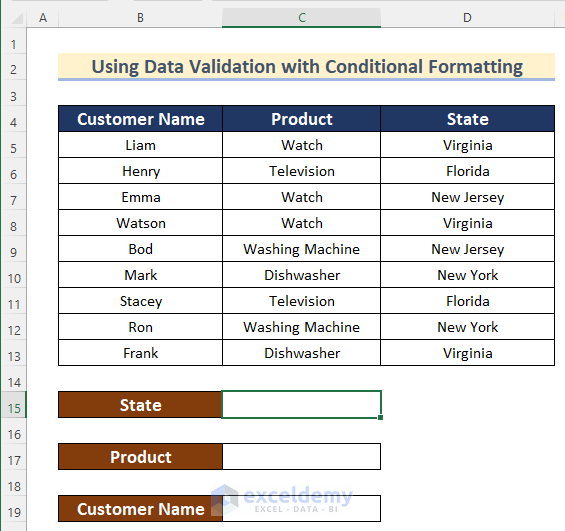
Steps:
- Select cell C15.
- Go to the Data tab.
- Click on Data Validation.
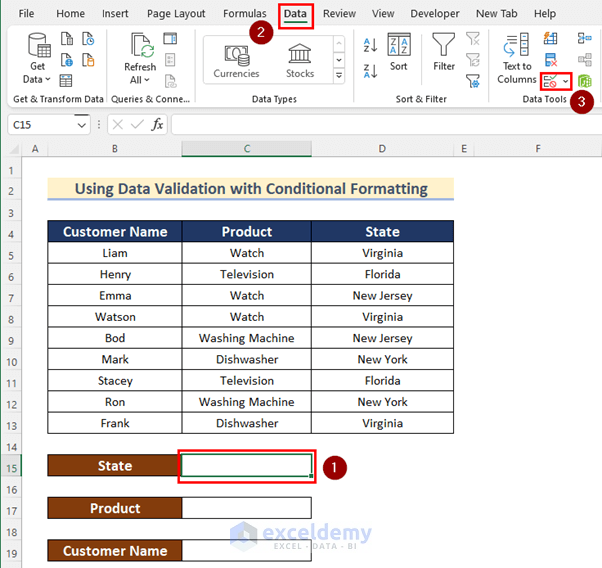
The Data Validation box will appear.
- Select List as the option for Allow.
- Select the range D5:D13 as Source.
- Click on OK.
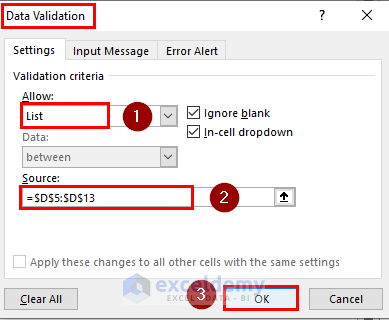
- Select the Range D5:D13.
- Go to the Home tab.
- Click on Conditional Formatting.
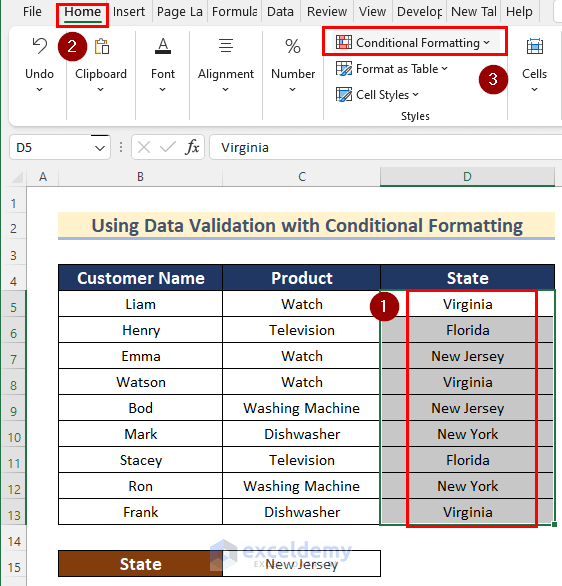
- Click on Highlight Cells Rules >> select Text that Contains.
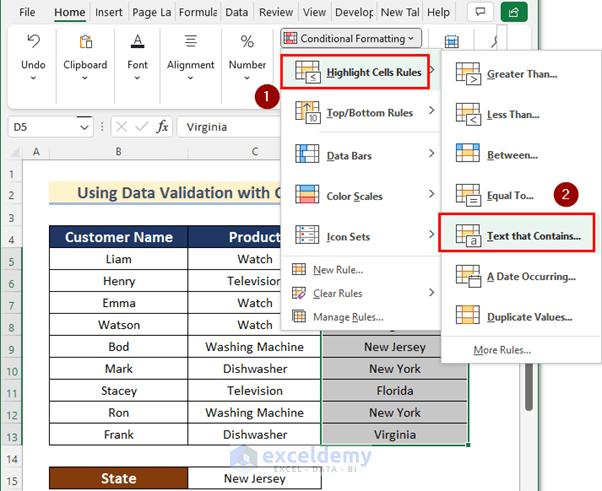
The Text That Contains box will open.
- Select cell C15 in the Format cells that contain the text box.
- Select Light Red Fill with Dark Red Text as Format.
- Click on OK.

- Select New Jersey in cell C15.
The Format will change automatically in cell D7 and cell D9.
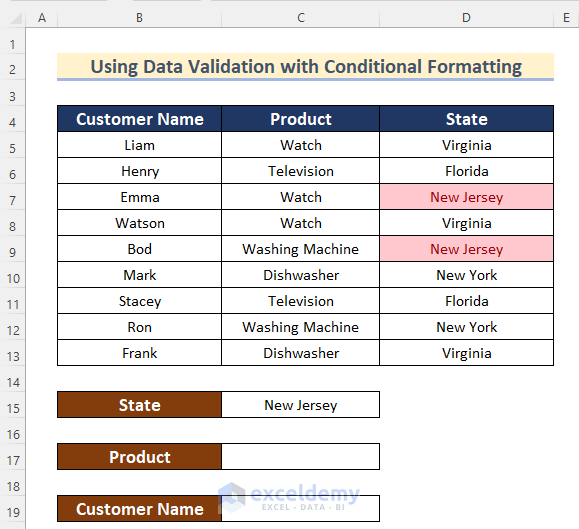
- Similarly, create search boxes for Column B and Column C and format the cells according to your preference using Data Validation with Conditional Formatting.
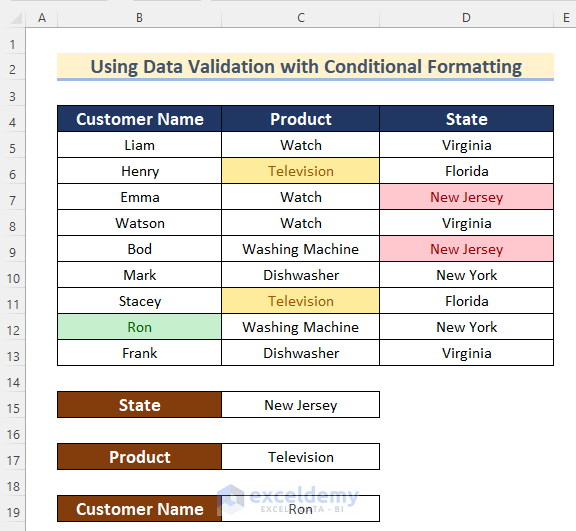
Download Practice Workbook
Related Articles
- How to Create a Search Box in Excel Without VBA
- Create a Search Box in Excel with VBA
- How to Create a Filtering Search Box for Your Excel Data
<< Go Back to Data Management in Excel | Learn Excel
Get FREE Advanced Excel Exercises with Solutions!
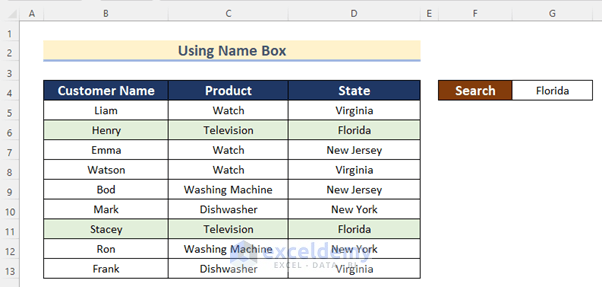


I have done this by using method number 3. however something has changed and now all my results are highlighted when the search box is empty. when i type a name in then i get the appropriate response, just highlighting what i want. once i clear the search box the entire column highlights again. Help!
Thanks JASON for your comment.
The issue you are encountering is the result of two potential situations. The first scenario is that you have implemented an additional conditional formatting within your data range. The second scenario is that you have not adjusted the formula to align with your data.
However, you can modify the formula for conditional formatting and replace it with the following one.
=IF(ISBLANK(Search_box),"",SEARCH(Search_box,$B5&$C5&$D5))Remove all the conditional formatting except the dedicated one given in the method. Also, check whether there are any VBA codes running in your worksheet affecting the changes.
Regards
Md Junaed Ar Rahman